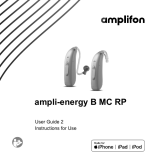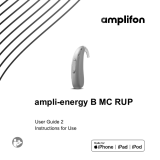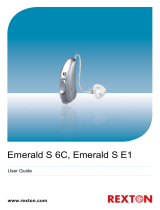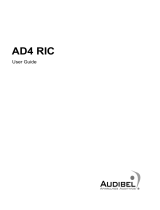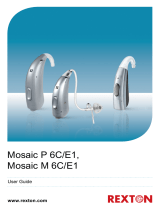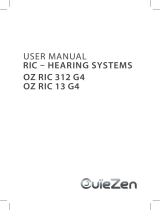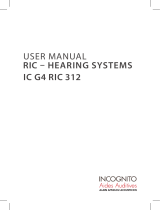Page is loading ...

ampli-mini R 312 6C
User Guide

2
Content
Welcome 4
Your hearing aids 5
Aid type 5
Getting to know your hearing aids 5
Components and names 7
Controls 10
Settings 12
Batteries 14
Battery size and handling tips 14
Replacing batteries 15
Daily use 17
Turning on and o 17
Inserting and removing the hearing aids 19
Adjuing the volume 24
Changing the hearing program 25
Further adjuments (optional) 26

3
Special liening situations 27
Setting the focus (optional) 27
On the phone 30
Audio induction loops 32
Maintenance and care 34
Hearing aids 34
Ear pieces 35
Professional maintenance 39
Further information 40
Wireless functionality 40
Accessories 40
Symbols used in this document 41
Troubleshooting 42
Country-specic information 44
Service and warranty 45

4
Welcome
Thank you for choosing our hearing aids to accompany you
through everyday life. Like anything new, it may take you a
little time to become familiar with them.
This guide, along with support from your Hearing Care
Professional, will help you underand the advantages and
greater quality of life your hearing aids oer.
To receive the mo benet from your hearing aids, it is
recommended that you wear them every day, all day. This
will help you get adjued to them.
CAUTION
It is important to read this user guide and the safety
manual thoroughly and completely. Follow the safety
information to avoid damage or injury.

5
Your hearing aids
This user guide describes optional features that your
hearing aids may or may not have.
Ask your Hearing Care Professional to indicate the
features that are valid for your hearing aids.
Aid type
Your hearing aids are a RIC (Receiver-in-Canal) model.
The receiver is placed within the ear canal and connected
to the aid via a receiver cable. The aids are not intended
for children under the age of 3 years or persons with a
developmental age of under 3 years.
Getting to know your hearing aids
It is recommended to familiarize yourself with your new
hearing aids. With the aids in your hand try using the
controls and note their location on the aid. This will make it
easier for you to feel and press the controls while wearing
the hearing aids.

6
If you have problems pressing the controls of your
hearing aids while wearing them, you can ask your
Hearing Care Professional about a remote control
option.

7
Components and names
➍
➍
➎
➎
➊Ear piece
➋Receiver
➌Receiver cable
➍Microphone openings
➎Rocker switch (control)
➏Battery compartment
(on/o switch)
➐Side indicator
(red = right ear,
blue = left ear)
➑Receiver connection

8
You can use the following andard ear pieces:
Standard ear pieces Size
Click Sleeve (vented or closed)
Click Dome™ single
(open or closed)
Click Dome semi-open
Click Dome double
You can easily exchange the andard ear pieces. Read
more in section "Maintenance and care".

9
Cuom-made ear pieces
Cuom shell
Click Mold™

10
Controls
With the rocker switch you can, for
example, adju the volume or switch
hearing programs. Your Hearing Care
Professional has programmed your desired
functions to the rocker switch.
You can also ask your Hearing Care Professional
whether a remote control or a smartphone app to
control your aids is available.

11
Rocker switch function L R
Press briefly:
Program up/down
Volume up/down
Tinnitus Function: volume up/down
Sound balance
Focus selection
(microphone-pattern adjument)
Press long:
Standby/turn on
Program up/down
Press very long:
Standby/turn on
L = Left, R = Right

12
Settings
Hearing programs
1
2
3
4
5
6
Read more in section "Changing the hearing program".
Features
Power-on delay enables while-free insertion of
hearing aids.
Read more in section "Turning on and o".
Autophone™ automatically switches to the
telephone program when the telephone receiver
approaches the ear.
Read more in section "On the phone".

13
XPhone transmits the telephone call into both ears
when the telephone receiver is held to either ear.
Read more in section "On the phone".
The Tinnitus Function generates a sound to
diract you from your tinnitus.
The wireless functionality enables simultaneous
control of both hearing aids.
Read more in section "Wireless functionality".

14
Batteries
When the battery is low the sound becomes weaker or you
will hear an alert signal. The battery type will determine how
long you have to replace or recharge the battery.
Battery size and handling tips
Ask your Hearing Care Professional for recommended
batteries.
Battery size: 312
zAlways use the correct battery size for your hearing aids.
zRemove the batteries if you intend not to use the hearing
aids for several days.
zAlways carry spare batteries.
zRemove empty batteries immediately and follow your
local recycling rules for battery disposal.

15
Replacing batteries
Removing the battery:
XOpen the battery compartment.
XUse the magnet ick to pull out the
battery. The magnet ick is available
as an accessory.

16
Inserting the battery:
XIf the battery has a protective lm, remove it
only when you are ready to use the battery.
XInsert the battery with the "+" symbol
facing up (refer to the picture).
XCarefully close the battery compartment. If you feel
resiance, the battery is not inserted correctly.
Do not attempt to close the battery compartment by force.
It can be damaged.

17
Daily use
Turning on and o
You have the following options to turn your hearing aids on
or o.
Via battery compartment:
XTurning on: Close the battery compartment.
The default volume and hearing program are set.
XTurning o: Open the battery compartment to the r
catch.
Via rocker switch:
XTurning on or o: Press and hold the rocker switch for
several seconds. Refer to section "Controls" for the
settings of the rocker switch.
After turning on, the previously used volume and
hearing program remain set.

18
When wearing the hearing aids, an alert tone can indicate
when an aid is being turned on or o.
When the power-on delay is activated, the hearing aids
turn on after a delay of several seconds. During this time
you can insert the hearing aids into your ears without
experiencing unpleasant feedback whiling.
The "power-on delay" can be activated by your Hearing
Care Professional.

19
Inserting and removing the hearing aids
Your hearing aids have been ne-tuned for your right and
left ear. Colored markers indicate the side:
zred marker = right ear
zblue marker = left ear
Inserting a hearing aid:
XFor Click Sleeves, take care that the
bend of the Click Sleeve is in line with
the bend of the receiver cable.
Correct:

20
Incorrect:
XHold the receiver cable at the bend closer to the
ear piece.
XCarefully push the ear piece in
the ear canal ➊.
XTwi it slightly until it sits well.
Open and close your mouth to
avoid accumulation of air in the
ear canal.
XLift the hearing aid and slide it
over the top of your ear ➋.
/



